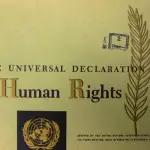
In general terms, there are two main types of human rights instrument: declarations and conventions. Declarations are simply statements by groups of nations, expressing an agreed position about human rights. Declarations have no binding legal effect, although signatory nations may choose to pass their own internal laws to protect these rights. Conventions are instruments of international law, so are consequently more binding. However a nation may sign or agree to a convention in principle, but choose not to ratify and/or to incorporate the requirements of the convention in its own domestic laws. Because there is no international court system responsible for protecting human rights, nations cannot be coerced into adhering to the conventions to which they have agreed.
Some examples of international declarations and conventions include:
The Universal Declaration of Human Rights (UDHR). The UDHR was formed in the wake of World War II. With the emergence of civilian deaths and atrocities in Europe, many nations urged the newly-formed United Nations to construct an instrument outlining the fundamental rights belonging to all people. A committee containing representatives from 18 nations, including Australia, was responsible for organising and finalising the draft document. In December 1948 the United Nations formally adopted the UDHR. It contains 30 articles expressing the rights and freedoms that should be available to all people, including life, liberty and security; freedom from slavery, torture, arbitrary arrest or exile; legal rights such as the presumption of innocence and the right to due process; the right to an education, to work, to shelter and an acceptable standard of living. As a constitutional document of the United Nations, the UDHR has some impact on nations who are UN members. It is often quoted to apply pressure to governments who are breaching the rights of their citizens. Courts in UN member states often cite its content in cases involving rights and freedoms.
The United Nations Convention on the Rights of the Child (UNCRC). The UNCRC was passed in November 1989 and came into effect the following year. To date, 194 nations have ratified or agreed to its terms; only two United Nations members, Somalia and the United States, have so far failed to do so. As a convention, the UNCRC is considered to be international law and is binding on nations that have ratified it. The UNCRC defines a child as anyone under the age of 18. The rights of children are defined in 40 articles and include the usual human rights, plus additional rights to enhance their survival, development and education. Signatory states are required to encourage and support parental and family guidance, offer effective education and support systems for children and protect children from harmful activities such as abuse, exploitation and child labour.
The United Nations Declaration on the Rights of Indigenous Peoples (UNDRIP). The UNDRIP was passed in 2007. As the name suggests it is concerned with the interests of native racial or ethnic groups, particularly in countries colonised by foreign powers, where indigenous populations are now a minority. The declaration calls on member states to recognise and protect indigenous peoples and their rights to culture, language, family and religious institutions, education, healthcare and connections with the land. Several countries – including Australia, New Zealand, Canada and the United States – refused to sign the declaration, claiming that its terms conflicted with their constitutions and previous treaties with indigenous treaties. The election of the Rudd government in late 2007 saw Australia later change tack and approve the declaration.
Though their legal impact is often negligible, these instruments have played a significant part in defining human, civil, political and legal rights around the world. The charters or bills of rights used internally in many nations have been informed by these international instruments. They have also promoted liberal human rights in places which lacked a historical or intellectual tradition of rights.
© lawgovpol.com 2014. Content on this page may not be republished or distributed without permission. For more information please refer to our Terms of Use.
